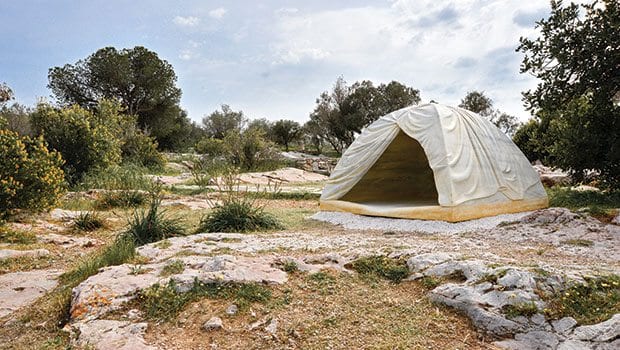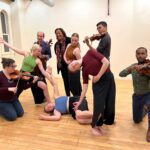Documenta 14 exhibits create political dialogue between Greece, Germany
‘Learning from Athens,’ taking place in Athens, Greece, and Kassel, Germany

On a hilltop overlooking the Acropolis in Athens, Greece, a tent stands in a clearing among olive trees. Its folds mimic the gentle draping of heavy fabric, and its wide door invites a visitor to enter and enjoy an eye-level view of the Parthenon, the temple built 2,400 years ago to honor the patron of Athens, the goddess Athena. But this tent is no ordinary traveler’s shelter. Instead of fabric, it is made of the same translucent, streaked marble as the Parthenon. Sculpted by Canadian artist Rebecca Belmore, the marble tent connects the classical past of Greece with the current crisis facing this nation and the world: the millions of people seeking refuge from war-torn homelands.
Flanked by the sea, Greece is at the crossroads of this crisis. Along the path to Belmore’s temple, nearby islands are visible along with large ships inching their way into Athens, a Mediterranean metropolis that is a gateway to Africa, the Middle East and Asia.
As the capital of Greece, Athens also is on the frontline of this nation’s conflict with Germany over stringent European Union economic measures. Pension cuts now reach low-income people, not just high earners, igniting frequent protest marches in Syntagma Square, in front of the Parliament Building.

Author: Fanis VlastarasMounira Al Solh, “Sperveri,” 2017, installation view, Museum of Islamic Art, Benaki Museum, Athens, documenta 14.
Beyond borders
Seizing an opportunity to create dialogue that eludes their politicians, artists are taking the lead in connecting Greece, Germany and the wider world. For the first time since its start in 1955, a decade after the end of World War II, the prestigious German exhibition of contemporary art entitled Documenta, held every five years in its home town, Kassel, is also underway in another city — Athens. Organized by Polish curator Adam Szymczyk, artistic director of Documenta 14, and a multinational team of curators who like him have lived in Greece for years, the exhibition engages 160 artists from more than 50 countries, who, like Rebecca Belmore, show work at both locations.
Entitled “Learning from Athens,” the 100-day Athens edition of Documenta 14 continues until August 16. The exhibition opened in Kassel on Saturday and runs until September 17.
On April 9, four equestrians departed on horseback from the Acropolis on a 1,850-mile ride to Kassel, a Baroque city rebuilt after World War II and the adopted home of the Brothers Grimm. Currently in Croatia, they expect to reach Kassel in July. A more subtle tribute to the Kassel-Athens partnership also took place on April 9, honoring an iconic project for Documenta 7 by Joseph Beuys (1921-1986), a charismatic artist and former Luftwaffe pilot. In 1982, he planted an oak tree in Kassel, the first of 7,000, to herald environmental and social activism. At the National Technical University of Athens, a center of resistance during Greece’s brutal military dictatorship during the ‘70s, Kosovo artist Sokol Beqiri planted a single oak tree grafted from an oak in Kassel.
The refugee crisis looms large among the works on view in Athens. No strangers to the suffering of refugees, Greece ended its war with Turkey over disputed lands with a 1922 treaty that forced the resettlement of more than one million Greek Orthodox Christians and about 500,000 Muslims.
Athenian delights
Inviting reflection and conversation, artists’ installations, performances, public programs and guided walks take place in 47 venues throughout Athens, including museums, institutions of higher education, pedestrian thoroughfares and hallowed historic sites.
In front of the City Hall of Athens, artist Rasheed Araeen and Organization Earth, a Greek nonprofit that advocates sustainable food production, conduct a program entitled “Shamiyaana — Food for Thought: Thought for Change.” Twice a day, the program prepares and serves a free lunch of organic produce to 60 people seated under canopies inspired by Pakistani wedding tents.
A short walk from the city’s jam-packed downtown is the Lyceum of Aristotle (384–322 BC), where the philosopher led his students in conversations as they strolled the grounds. The artist collective Postcommodity has erected a sound installation on the site inspired by Aristotle’s practice of “peripatetic learning,” which engages both body and mind. As visitors walk a path encircling the site that is fragrant with lilacs and flowering rosemary, they listen to stories of refugees in multiple languages.
Old and new
Nearby is the Athens Conservatoire, also known as the Odeion. The city’s oldest music school, the Odeion occupies a slapped-together looking building that encloses a formerly open-air amphitheater. Here, Nigerian artist Emeka Ogboh has fashioned an elegant installation entitled “The Way Earthly Things Are Going.” As a brightly lit LED display of real-time world stock indexes crawls across a wall, multichannel speakers broadcast a female a cappella choir singing a traditional Greek song that laments loss of homeland.
Documenta’s largest Athens venue is the new National Museum of Contemporary Art, handsomely converted from a long-vacant brewery. Mingling art and daily life, views through its large windows showcase the neighborhood, where prewar stucco buildings with tile roofs, although dilapidated, are more picturesque than the modern buildings flanking them. By the windows is an installation on the city’s growing stock of abandoned housing, left behind by owners who cannot keep up with taxes.
Multimedia immersion
Video and sound installations dominate Documenta sites. Among the most memorable is “Tripoli Cancelled,” by Naeem Mohaiemen, a fictional film partly based on a real-life ordeal of the artist’s Bangladeshi father, who was once confined at an Athens airport due to missing paperwork. Distinguished actor Vassili Koukalani plays the role of a man stranded in an empty airport for 10 days in the film, which is silent except for musical interludes. The camera dwells on the stylish geometry of the setting — the now-closed Hellenikon Airport in Athens, designed by renowned architect Eero Saarinen — between scenes of its sole character as he tries to maintain daily routines. He shaves, sleeps, eats canned foods and talks silently into the camera. Climbing into an empty plane, he dons a steward’s uniform and mimes the act of welcoming passengers.
One’s homeland also can impose a state of confinement, as Palestinian photographer Ahlam Shibli documents in her absorbing series of 32 prints entitled “Occupation.” Each is an intimate view of daily life in al-Khalil/Hebron, a Palestinian neighborhood under siege by the Israeli military because of its proximity to a Zionist settlement.
French filmmaker Michael Auder’s clever “Gulf War TV War” (1991, edited 2017) induces a sense of déjà vu. His film is a montage of video clips he shot of his TV as it played American newscasts leading up to two Gulf wars — George H. W. Bush’s “Operation Desert Storm” in 1990 and his son’s “Operation Iraqi Freedom” in 2003. Reshuffling these once-familiar images, the film suggests that history is repeating itself. Scenes of antiwar demonstrators, interviews with pundits and politicians (including a young Joe Biden), and commercials seem part of a never-ending news cycle.
Displacement as art
In the hangar-sized exhibition hall of the Athens School of Fine Arts (ASFA), one of many curtained viewing rooms shows “Glimpse,” a searing 20-minute video by Polish filmmaker Artur Zmijewski. Quoted in the Dokumenta 14 Daybook, a collection of essays profiling participating artists, Zmijewski writes, “So when those in power start using an exclusionary rhetoric, averse to immigrants or refugees, the latter start being harassed or attacked in the streets.”
“Glimpse” alternates between documentary-style views of a French camp that once held 6,000 refugees — slowly panning on heaps of bedding, rubble, and shacks — and staged close-ups of refugees in camps and on the streets in Berlin and Paris. Standing before a shelter, smiling kids hold new toys. Someone — perhaps the filmmaker — hands new boots to a man who eagerly replaces his frayed sneakers, grinning into the camera. Another dons a new coat, and, as instructed, turns his back to the camera while the man who gave it to him paints a large white X on his back — a jolting image of vulnerability.
Tents are evocative images of shelter. At the Benaki Museum of Islamic Art, Beirut-born Mounira Al Solh’s embroidered tent lets Middle Eastern and North African refugees speak for themselves. Inside the tent is a book of stories drawn from the artist’s interviews with displaced people. They describe their suffering and also their hopes, as they begin the process of becoming citizens in adopted homelands.

![Banner [Virtual] Art Gallery](https://baystatebanner.com/wp-content/uploads/2024/04/NJ-H_1-150x150.jpg)


![Banner [Virtual] Art Gallery](https://baystatebanner.com/wp-content/uploads/2024/04/NJ-H_1-713x848.jpg)

